Experience the Magic of Huangshan Scenic Area: Best Times to Visit and What to Expect
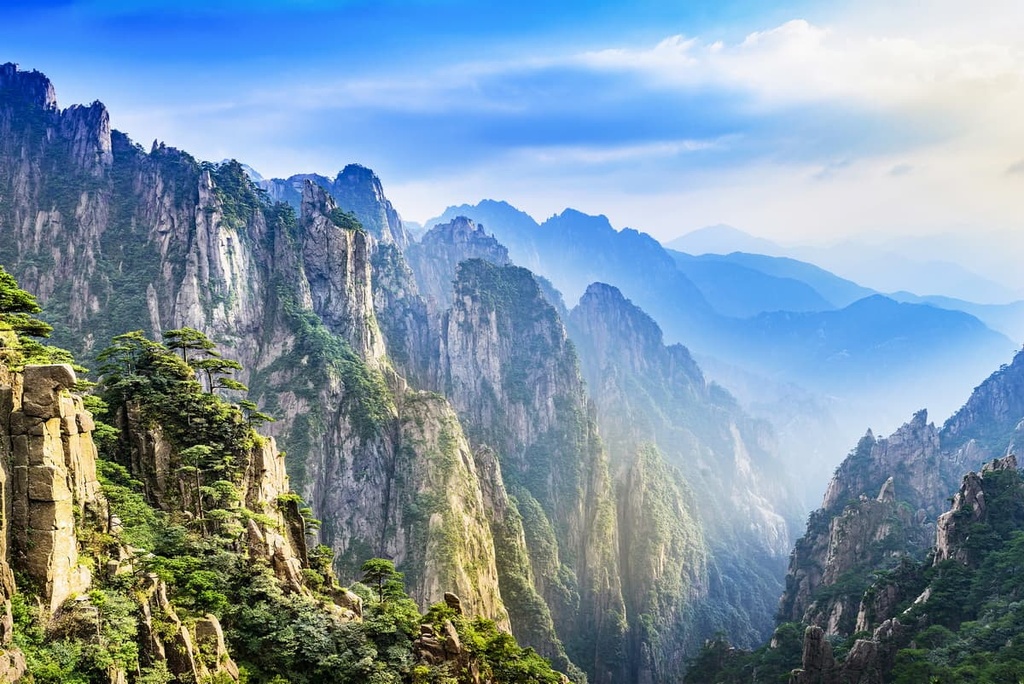
An Essential Guide to Visiting Huangshan Scenic Area
Nestled in southern Anhui province, Huangshan Mountain, or the Yellow Mountain, is a breathtaking masterpiece of nature that has enchanted travelers for centuries. Renowned for its stunning granite peaks, twisted pines, and ethereal sea of clouds, this UNESCO World Heritage Site is a must-visit for anyone seeking to immerse themselves in China’s rich natural beauty. As you traverse its winding trails and gaze upon the awe-inspiring landscapes that have inspired poets and painters alike, you’ll understand why Huangshan is celebrated as one of the most picturesque locations in the world.
Whether you’re an avid hiker eager to conquer its famous peaks or a casual visitor looking to soak in the scenic vistas from the comfort of a cable car, Huangshan offers a diverse range of experiences tailored to every traveler’s desire. With its enchanting sunrises and sunsets, lush flora, and the occasional mystical blanket of fog, each moment spent here is a chance to witness the sublime artistry of nature.
However, to truly appreciate all that Huangshan has to offer, a little planning goes a long way. From selecting the ideal time to visit, navigating its impressive landscape, to choosing the best accommodations, this guide will equip you with essential tips and insights to make your journey to Huangshan an unforgettable adventure. Prepare to be captivated by the magic of the Yellow Mountain, where every step leads to new wonders and every view is a postcard-perfect memory waiting to be captured.
In This Guide
- An Essential Guide to Visiting Huangshan Scenic Area
- The Rich History and Legends of Huangshan Scenic Area
- Main Highlights: What You Absolutely Can’t Miss
- Planning Your Visit: A Practical Guide
- Tickets: Prices, Booking, and Tips
- How to Get There: A Complete Transportation Guide
- Local Cuisine and Accommodation Nearby
- Frequently Asked Questions
- Final Thoughts on Your Trip
The Rich History and Legends of Huangshan Scenic Area
Huangshan Mountain, also known as Yellow Mountain, is not just a natural wonder; it is a tapestry woven with rich history and legends that have captivated travelers for centuries. This majestic mountain range, which was designated a UNESCO World Heritage Site in 1990, has long been a source of inspiration for poets, painters, and philosophers throughout Chinese history.
The history of Huangshan dates back to the ancient times of the Qin Dynasty (221-206 BC), when it was first recorded in texts. It was during the Tang Dynasty (618-907 AD) that Huangshan began to emerge as a significant cultural symbol in China, attracting scholars and artists who sought to capture its ethereal beauty. The peaks and pines became immortalized in countless traditional Chinese paintings, with their distinctive granite formations and breathtaking vistas serving as the backdrop for philosophical contemplation and artistic expression.
Among the many legends that surround Huangshan, one of the most popular is that of the “Guest Greeting Pine” (Yingbin Song), a famous tree that has stood for over a thousand years. According to local folklore, this ancient pine has welcomed countless travelers, providing them with shade and a sense of tranquility as they journeyed through the rugged terrain. It is said that this tree has witnessed the rise and fall of dynasties, embodying the spirit of resilience and hospitality that characterizes the mountain itself.
Another enchanting tale is that of the “Immortal’s Leap,” which tells of a legendary figure who leaped from one peak to another to escape his enemies. Some believe that this act of bravery granted him immortality, and the spot where he landed is now marked by a rock formation that continues to draw adventurous spirits. Such legends imbue the landscape with a mystical essence, inviting visitors to explore the paths where history and myth intertwine.
Huangshan also holds a significant place in Chinese philosophy and spirituality. The peaks are revered as sacred grounds, where Taoist monks once sought enlightenment amidst the serene beauty of nature. The mountain is often associated with the concept of “Dao,” the way of nature, which emphasizes harmony and balance. This spiritual connection is palpable as you hike along the trails, where every step feels like a journey into the soul of the earth.
Throughout the centuries, Huangshan has remained a beloved destination for those seeking both adventure and introspection. Its rugged trails, towering peaks, and the mesmerizing sea of clouds that often envelops the landscape create a sense of wonder that transcends time. With each sunrise and sunset, the mountains transform, revealing a palette of colors that has inspired artists and dreamers alike.
Today, Huangshan continues to draw travelers from around the globe, eager to experience its natural beauty and rich cultural heritage. As you stand atop one of its highest peaks, gazing out over the breathtaking panorama, you become part of a legacy that stretches back through the ages—a legacy that celebrates the enduring power of nature and the stories that lie within its embrace.
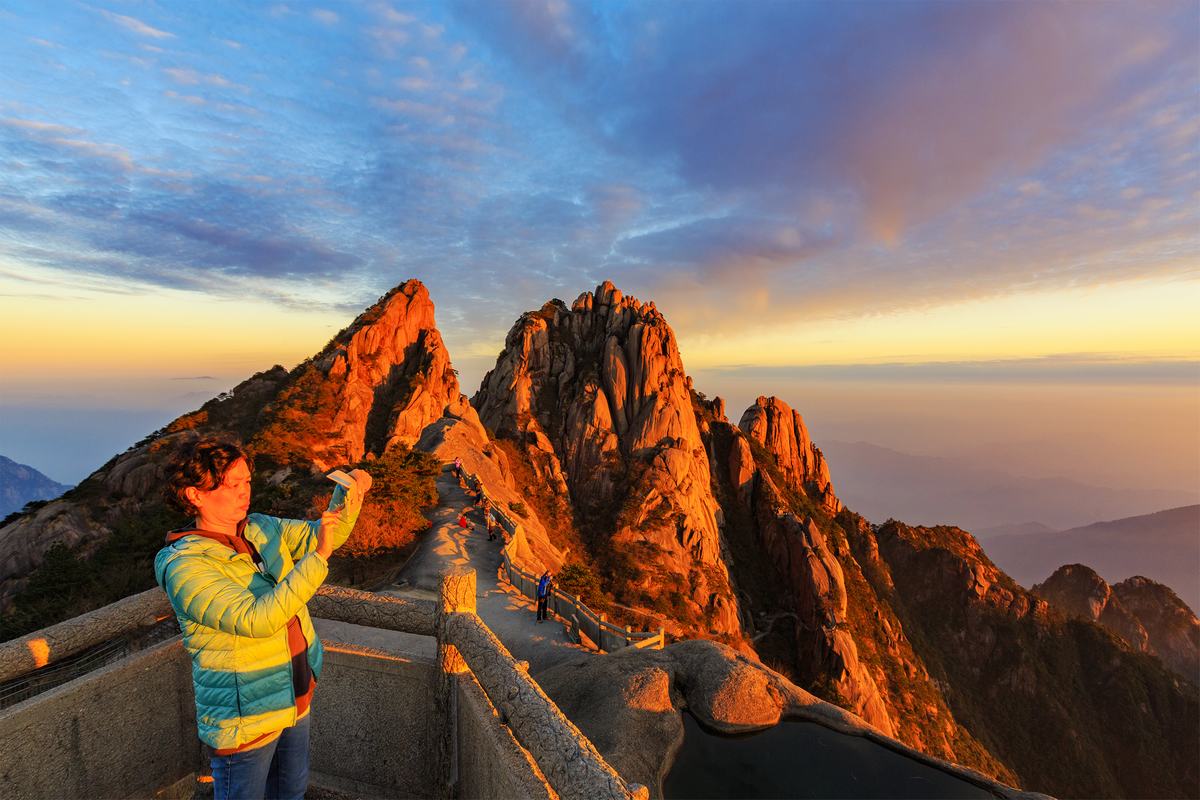
Huangshan Scenic Area.
Main Highlights: What You Absolutely Can’t Miss
Huangshan Scenic Area, also known as Yellow Mountain, is a breathtaking destination that offers a wealth of natural beauty and cultural significance. Here’s a guide to the main highlights that you absolutely can’t miss while exploring this remarkable UNESCO World Heritage site.
Iconic Peaks
-
Lotus Peak (Lianhua Feng)
Standing at 1,864 meters (6,115 feet), Lotus Peak is the highest point in Huangshan. The summit provides panoramic views that are nothing short of spectacular, especially during sunrise and sunset. The unique contours of the peak, resembling a lotus flower, make it a favored spot for photography enthusiasts. -
Bright Summit (Guangming Ding)
Just slightly lower than Lotus Peak, Bright Summit reaches an elevation of 1,860 meters (6,102 feet). This peak is renowned for its breathtaking vistas and is easily accessible via well-maintained paths. The viewpoint offers a perfect vantage point to witness the ethereal sea of clouds that frequently blankets the mountain. -
Celestial Capital Peak (Tiandu Feng)
At 1,829 meters (6,000 feet), Celestial Capital Peak is famous for its dramatic rock formations and is often seen as a symbol of Huangshan. The hiking trails leading to its summit are lined with ancient pines that add a mystical quality to the landscape.
Scenic Areas
-
West Sea Canyon (Xihai Great Canyon)
A highlight for hikers, the West Sea Canyon features thrilling cliffside pathways and a stunning loop trail that offers breathtaking views. The Cloud Dispersing Pavilion, located at the canyon’s entrance, provides an excellent panorama of the valley below. Whether you choose to hike the full circuit or just a portion, the scenery is sure to leave you in awe. -
Yuping Scenic Area
This area is known for its majestic landscapes and iconic attractions such as the Guest-greeting Pine, which appears to welcome every visitor. The viewing platform at Yuping Tower is a must-visit for those wanting to experience the sea of clouds enveloping the mountains. -
Beihai Scenic Area
Nestled in the Back Mountain region, Beihai offers serene views with spots like Beginning-to-Believe Peak and Monkey Watching the Sea. This area is less crowded and provides a more tranquil experience, perfect for those looking to connect with nature.
Unique Experiences
-
Sunrise and Sunset Viewing
To fully experience the magic of Huangshan, plan to stay overnight at one of the mountaintop hotels. The early morning sun and the evening glow create a spectacle that is truly unforgettable. The West Sea Hotel is often recommended for its proximity to the best viewing spots. -
Cable Car Rides
Save your energy for the trails by taking one of the three cable cars (Yungu, Taiping Telpher, and Yuping) that whisk you partway up the mountain. This allows you to focus on hiking the scenic paths and enjoying the views without the strenuous climb.
Practical Tips
-
Best Time to Visit: The ideal months to visit are April to June and September to November when the weather is mild and the scenery is at its most vibrant. However, winter can offer unique photographic opportunities with snow-covered peaks.
-
Planning Your Visit: Given the vastness of Huangshan, it’s crucial to plan your hiking routes in advance. Guided tours can provide insights and help you navigate the best trails based on your fitness level and interests.
-
Accommodation: Book your stay in advance, especially during peak seasons, as accommodations at the top can fill up quickly. If you prefer a more budget-friendly option, consider staying in Tangkou village at the foot of the mountain.
Conclusion
Huangshan Scenic Area is not just a place to visit; it’s an experience that invites you to immerse yourself in nature’s grandeur. From the iconic peaks to the serene hiking trails and breathtaking sunrises, every moment spent here is a memory in the making. Don’t miss out on these highlights as you explore one of China’s most treasured landscapes!
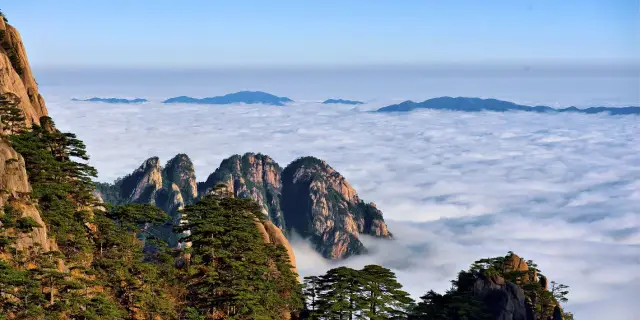
Huangshan Scenic Area.
Planning Your Visit: A Practical Guide
Planning Your Visit: A Practical Guide
Huangshan Scenic Area, often referred to as Yellow Mountain, is a breathtaking destination that promises a unique blend of natural beauty, cultural heritage, and outdoor adventure. To ensure your trip is memorable and fulfilling, here’s a comprehensive guide to help you navigate your visit.
Getting There
Huangshan Scenic Area is approximately 500 km (310 miles) southwest of Shanghai, making it accessible via a 2.5-hour bullet train ride. The nearest major city is Huangshan, which is around an hour’s drive from the scenic area. From Huangshan North Bullet Train Station or the city bus station, you can catch a bus to Tangkou town, where shuttle buses will take you to the Ciguangge (Front Mountain) or Yungusi (Back Mountain) ticket offices.
Travel Tip: Private cars cannot enter the scenic area, so if you are driving, park at the Zhaixi transfer center and take the shuttle bus.
Ticketing and Opening Hours
- Scenic Area Ticket:
- 190 RMB (January 21 to November 19)
- 150 RMB (November 20 to January 20)
- Shuttle Bus: 19 RMB (round trip)
- Cable Cars:
- Yungu/Taiping: 80 RMB (January 21 to November 19) / 65 RMB (November 20 to January 20)
- Yuping: 90 RMB (January 21 to November 19) / 75 RMB (November 20 to January 20)
- Opening Hours:
- Scenic Area: 6:20 AM – 5:30 PM (March 2 to October 31); 7:20 AM – 4:30 PM (November 1 to March 1)
- Cable Cars: 6:20 AM – 5:40 PM (March 2 to October 31); 7:20 AM – 4:40 PM (November 1 to March 1)
Note: Plan to arrive early, as the area can get crowded, especially during peak season or holidays.
Best Time to Visit
While Huangshan is stunning year-round, the best times to visit are during spring (April to June) and autumn (September to November). Spring offers blooming flowers and frequent sea of clouds, while autumn showcases vibrant foliage against a backdrop of clear skies. If you’re a fan of winter landscapes, visiting from December to February can grant you the chance to see snow-covered peaks and frosty rime ice, although some areas may be closed due to weather conditions.
Avoid: Peak tourist seasons, particularly during Chinese holidays and the school break months of July and August, to sidestep large crowds.
Accommodation
For those hoping to catch the sunrise or sunset at Huangshan, overnight stays in mountain hotels are a must. The West Sea Hotel is highly recommended, but be prepared for higher prices and the need for advance booking, especially during peak times. If you prefer a more budget-friendly option, consider staying in Tangkou village at the foot of the mountain and starting your hike early the next day.
Luggage Tip: Carry only an overnight backpack and leave larger bags in your downtown hotel or at the foot of the mountain checkroom.
Hiking and Scenic Exploration
Huangshan is a hiker’s paradise, with a variety of trails leading to stunning viewpoints. The most famous peaks include:
- Lotus Peak (Lianhua Feng): The highest peak offering breathtaking views.
- Bright Summit (Guangming Ding): Known for panoramic vistas.
- Celestial Capital Peak (Tiandu Feng): Famous for its unique rock formations.
For a popular hiking experience, the West Sea Canyon (Xihai Great Canyon) offers a loop trail that takes about five hours, with shuttle options available for those who prefer less strenuous exploration.
Hiking Tip: Most paths are paved, but they involve many stairs. Wear comfortable hiking shoes and be courteous to porters carrying heavy loads.
Food and Amenities
While there are small stalls along the mountain selling snacks and drinks, prices are higher than in town. For a proper meal, head to one of the hotel restaurants. Clean toilets are available along the hiking paths, making it convenient for visitors.
Final Reminders
- Cable Car Schedules: Be mindful of cable car timings. Missing the last ride can result in a lengthy hike down.
- Weather Conditions: Check the weather forecast before your trip, as sections of the mountain may close during adverse conditions.
With these tips in hand, you’re ready to embark on an unforgettable adventure at Huangshan Scenic Area, where nature’s beauty and rich cultural heritage await you!

Huangshan Scenic Area.
Tickets: Prices, Booking, and Tips
Visiting the breathtaking Huangshan Scenic Area is a must for any international traveler exploring China. The journey begins with securing your tickets, which are essential for accessing this UNESCO World Heritage Site known for its striking granite peaks, iconic pine trees, and surreal sea of clouds. Here’s what you need to know about ticket prices, booking options, and handy tips to enhance your experience.
Ticket Prices
Entrance fees to Huangshan are structured by season:
– Huangshan Scenic Area Ticket:
– 190 RMB (January 21 to November 19)
– 150 RMB (November 20 to January 20)
Additionally, if you plan to use the shuttle bus and cable cars, here are the costs:
– Shuttle Bus Ticket (Round Trip): 19 RMB
– Yungu/Taiping Cable Car (Single Trip):
– 80 RMB (January 21 to November 19)
– 65 RMB (November 20 to January 20)
– Yuping Cable Car (Single Trip):
– 90 RMB (January 21 to November 19)
– 75 RMB (November 20 to January 20)
– West Sea Canyon Tram (Single Trip):
– 100 RMB (January 21 to November 19)
– 80 RMB (November 20 to January 20)
Booking Tickets
Tickets can be purchased at the entrance but to avoid long queues and ensure availability, especially during peak seasons, it’s advisable to book your tickets in advance. Many travelers opt to buy their tickets online through various travel agencies or directly through the official Huangshan ticketing website. Consider pre-booking cable car tickets as well, as they can be limited during busy times.
Tips for a Smooth Visit
-
Plan Ahead: Given the vast area to explore, plan your hiking routes in advance. Consider how much time you have and the specific sights you want to see. Popular trails like the West Sea Canyon offer various options for different fitness levels.
-
Cable Cars: Using the cable cars can save you significant energy for the scenic hikes at the top. If you choose to hike up, be prepared for a strenuous trek that could take several hours.
-
Accommodation: If you want to catch the sunrise or sunset over the peaks, consider staying overnight at one of the mountain hotels. The West Sea Hotel is highly recommended, but be aware that prices can be steep, and booking in advance is crucial during peak seasons.
-
Time Your Visit: To enjoy a less crowded experience, avoid visiting during Chinese holidays and school summer breaks (July to August). The best times for a visit are in spring (April to June) and autumn (September to November), when the weather is pleasant and the scenery is at its most picturesque.
-
Stay Hydrated and Prepared: Bring along water and snacks, as prices on the mountain can be high. Comfortable hiking shoes are a must, given the terrain you’ll encounter.
-
Weather Awareness: Be prepared for rapidly changing weather conditions. Check forecasts and be mindful that some areas may close due to bad weather, especially in winter.
By keeping these details in mind, your journey to Huangshan Scenic Area can be both memorable and enjoyable. So, pack your hiking shoes and camera, and get ready to experience one of China’s most stunning landscapes!
How to Get There: A Complete Transportation Guide
Getting to the majestic Huangshan Scenic Area, known for its breathtaking granite peaks and enchanting sea of clouds, is an adventure in itself. Below is a comprehensive transportation guide to help international travelers navigate their way to this stunning destination.
Arriving by Air
The nearest major airport to Huangshan is Huangshan Tunxi International Airport (TXN). This airport services flights from several major cities in China, including Shanghai, Beijing, and Guangzhou. Upon arrival, you have a few options to reach the Huangshan Scenic Area:
- Airport Shuttle Bus: Direct buses run from the airport to Huangshan city, taking about 30 minutes.
- Taxi: Taxis are available at the airport for a more convenient and direct trip to your accommodation in Huangshan city or Tangkou. The journey should take around 30-40 minutes.
Arriving by Train
For those preferring train travel, Huangshan has a high-speed railway station called Huangshan North Station, which connects to several major cities across China.
- From Shanghai: You can take a bullet train from Shanghai Hongqiao Railway Station to Huangshan North Station, which takes approximately 2.5 hours.
- From Hangzhou: Trains from Hangzhou to Huangshan also run regularly, taking about 1.5 hours.
Once you arrive at Huangshan North Station, you can get to the scenic area as follows:
- Take a Bus: Buses depart from Huangshan North Station to Tangkou, the nearest town to Huangshan Scenic Area, taking around 1 hour.
- Private Transfer: If you prefer a more direct route, consider booking a private transfer in advance.
From Huangshan City to Tangkou
If you choose to stay in Huangshan city, you can easily reach Tangkou, the gateway to Huangshan Scenic Area:
- Bus Service: There are frequent buses from Huangshan city bus station to the Zhaixi Bus Transfer Center in Tangkou. The trip takes about an hour.
- Taxi: A taxi ride is also a convenient option and typically takes around 40 minutes.
Reaching the Scenic Area
Upon reaching Tangkou, you’ll need to take a shuttle bus to the Huangshan Scenic Area:
- Shuttle Bus: The shuttle bus runs regularly from Tangkou to either the Ciguangge (Front Mountain) or Yungusi (Back Mountain) ticket offices. The bus ride takes about 15 minutes.
Important Notes
- Private Vehicles: Be aware that private cars are not permitted to enter the scenic area. If you’re driving yourself, you’ll need to park at the Zhaixi transfer center and take the shuttle bus from there.
- Ticket Purchase: Tickets for the Huangshan Scenic Area can be purchased at the entrance. It’s advisable to pre-book your tickets online during peak seasons to avoid long queues.
Cable Cars and Hiking
Once inside the scenic area, you can choose to either hike up the mountain or take advantage of the cable cars:
- Cable Cars: Three cable cars — Yungu, Taiping Telpher, and Yuping — take visitors to various heights on the mountain. Each cable car ride costs between 65 RMB to 90 RMB one way, depending on the season.
- Hiking: For the more adventurous, hiking up the mountain is an option. However, be prepared for a strenuous trek with thousands of steps.
Accommodation Considerations
To fully enjoy the stunning sunrises and sunsets, consider staying overnight at one of the hotels on the mountain. The West Sea Hotel is a popular choice but remember to book in advance during peak seasons.
Final Thoughts
With its awe-inspiring landscapes and rich natural beauty, reaching Huangshan Scenic Area is part of the adventure. Whether you arrive by air, train, or bus, each step brings you closer to experiencing one of China’s most extraordinary destinations. Be sure to plan your transportation in advance to ensure a smooth and enjoyable journey!
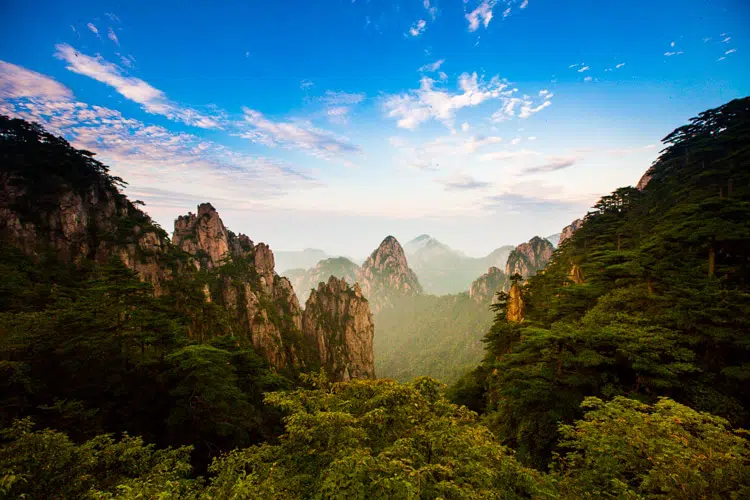
Huangshan Scenic Area.
Local Cuisine and Accommodation Nearby
When exploring the breathtaking landscapes of Huangshan Scenic Area, indulging in the local cuisine and finding the right place to stay can enhance your travel experience significantly.
Local Cuisine
Huangshan is not just about stunning views; it’s also a delight for food lovers. The region is renowned for its unique culinary offerings, influenced by the flavors of Anhui Province.
-
Huangshan Braised Tofu (黄山臭豆腐): A must-try dish, this local specialty features tofu that is fermented to develop a strong flavor, served with a savory sauce. Its unique taste and aroma may surprise you!
-
Bamboo Shoots: Fresh bamboo shoots are harvested from the surrounding mountains and are often stir-fried with local vegetables or added to soups. They offer a crunchy texture and a subtle earthiness that complements many dishes.
-
Huangshan Smoked Duck (黄山烟熏鸭): This dish is a local favorite, prepared through a special smoking process that infuses rich flavors into the tender duck meat. Often served with a side of rice or vegetables, it’s a hearty meal after a day of hiking.
-
Jin’An Wine (金安酒): Don’t miss the chance to sample this local rice wine, known for its sweet and fragrant profile. It pairs wonderfully with many dishes and is a popular choice among locals and visitors alike.
For a true taste of Huangshan, consider dining at local restaurants in Tangkou Village, where you can find a variety of eateries offering these regional specialties.
Accommodation Options
To make the most of your visit to Huangshan, choosing the right accommodation is key. Whether you prefer staying on the mountain or at the foot of it, there are options to suit every traveler:
-
West Sea Hotel (西海饭店): This is the best option for those looking to stay on the mountain. Located near the West Sea Grand Canyon, it provides easy access to hiking trails and stunning sunrise views. The hotel offers comfortable rooms and a restaurant serving local cuisine, though prices can be on the higher side, especially during peak season.
-
Yuping Hotel (玉屏楼): Another great mountain option, this hotel is conveniently situated close to several scenic areas. It features cozy accommodations and a restaurant with a variety of dishes, making it an excellent choice for hikers wanting to stay overnight.
-
Tangkou Village Hotels: If you prefer a more budget-friendly option or a traditional experience, numerous guesthouses and hotels are available in Tangkou Village, located at the foot of Huangshan. Here, you can find charming local inns, some of which offer hot springs for relaxation after a day of hiking.
-
Hot Springs Resorts: For those looking to unwind, consider staying at one of the hot springs resorts in the area. They provide a luxurious experience with spa treatments and relaxing hot spring baths, perfect for rejuvenating your body and mind after exploring the rugged terrain.
Make sure to book your accommodations in advance, especially during peak seasons, to secure your preferred stay and enjoy the best of Huangshan’s local culture and hospitality.
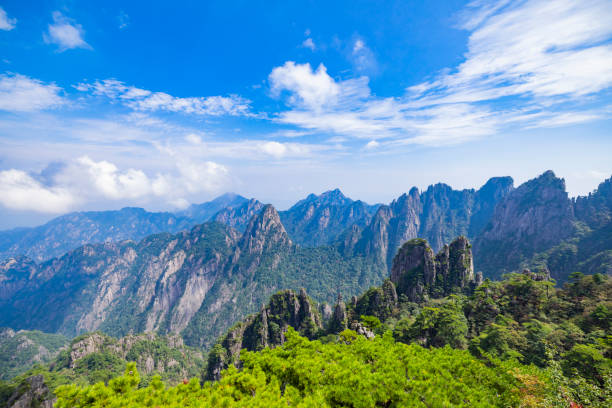
Huangshan Scenic Area.
Frequently Asked Questions
Frequently Asked Questions
1. What is the best time to visit Huangshan Scenic Area?
Huangshan is beautiful year-round, but the ideal times to visit are during spring (April to June) and autumn (September to November). These seasons offer mild weather, blooming flowers, and stunning fall foliage. If you want to experience the majestic sea of clouds, consider visiting in winter, although some areas may be closed due to weather conditions.
2. How do I get to Huangshan Scenic Area from major cities?
Huangshan is approximately 500 km (310 miles) southwest of Shanghai. The easiest way to reach it is by taking a bullet train to Huangshan North Station, followed by a bus to Tangkou town, where you can catch a shuttle bus to the entrance of the scenic area.
3. Are there accommodation options on the mountain?
Yes, there are several hotels on the mountain, with the West Sea Hotel being the most recommended for its location and views. However, accommodations can be pricey. It’s advisable to book in advance, especially during peak seasons. Alternatively, you can stay in Tangkou village at the base of the mountain and start your hike early the next day.
4. How long does it take to hike in Huangshan?
The time required for hiking depends on your chosen trails. A popular loop trail in the West Sea Canyon takes about five hours. If you only want to hike part of the trail, you can do so in approximately two and a half hours. Remember, the paths are paved but involve many steps, so come prepared for a workout!
5. What are the cable car options available?
Three main cable cars provide access to different parts of Huangshan: Yungu, Taiping Telpher, and Yuping. Taking a cable car can significantly reduce your hiking time and conserve energy for exploring the stunning mountain top views.
6. What should I wear and bring for my visit?
Wear comfortable hiking shoes, as the paths can be steep and uneven. Dress in layers, as temperatures can vary throughout the day. It’s also a good idea to carry an overnight backpack if you plan to stay on the mountain, along with snacks, water, and your camera for those breathtaking views!
7. Are there dining options available on the mountain?
Yes, there are small stalls selling snacks, drinks, and hot meals at increased prices. For a more formal dining experience, you can eat at the hotel restaurants. Be mindful that options may be limited, so plan accordingly.
8. What safety precautions should I take while hiking?
Always pay attention to the weather conditions, as they can change rapidly in the mountains. Follow the marked trails, be cautious of slippery areas, and stay hydrated. If you’re hiking during peak times, be considerate of porters carrying heavy loads; yield to them to ensure a safe passage for everyone.
Final Thoughts on Your Trip
As your journey through the breathtaking Huangshan Scenic Area comes to a close, take a moment to reflect on the memories woven into the fabric of this majestic mountain range. From the ethereal sea of clouds that envelops the peaks at dawn to the timeless beauty of the iconic Huangshan pines, every vista offers a unique perspective on nature’s artistry.
Whether you ventured along the exhilarating trails of the West Sea Canyon or marveled at the striking silhouettes of granite formations under the golden hues of sunset, each step unveils a new layer of wonder. This UNESCO World Heritage Site is not just a destination; it’s an experience that stirs the soul and ignites the spirit of adventure.
As you descend from these storied heights, carry with you the tranquility and beauty of Huangshan, a place where nature and culture intertwine seamlessly. Allow the serenity of the mountain to linger in your heart long after you leave, inspiring your future explorations. Until we meet again, may the memories of Huangshan accompany you on your travels, reminding you of the incredible beauty that our world has to offer. Safe travels!